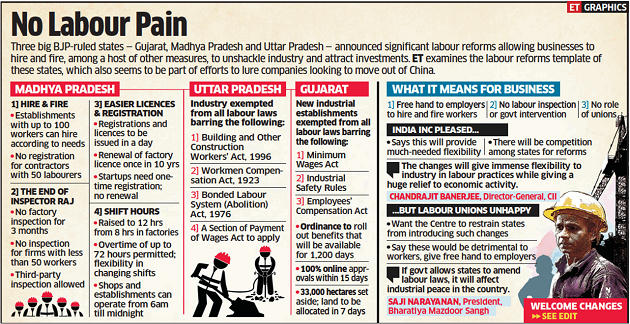Table of Contents
Labour Laws

Welcome Changes To Labour Laws
- We welcome the move by BJP states Uttar Pradesh and Madhya Pradesh — with Gujarat seeking to follow suit via an Ordinance — to temporarily suspend the operation of labour laws, to help production struggle its way out of the hole in which it finds itself in the wake of seven weeks of lockdown.
- India had 45 labour laws at the level of the Centre and about 200 labour laws at the level of the states.
- Till the Modi government decided to streamline the central laws into 4 codes on industrial relations, wages, social security and occupational safety.
- The last three have been legislated into law, while the first one remains a work in progress.
- The current move must be seen as an earnest governmental effort to revive the economy and breathe some life into the animal spirits that have gone into a swoon.
- Labour is a concurrent subject, in which the Centre and the states can make laws.
- Where there is any conflict between a central law and a state law on the same subject, the central law will prevail.
- Madhya Pradesh has done well to let shops stay open from 6 am to 12 midnight.
- Keeping shops open longer is the only way to prevent crowding of shoppers.
Fresh Air
- Lockdown and a dramatic reduction in air pollution.
- Air pollution in north India has dropped to a 20-year low.
- Harvard University study establishes a correlation between long-term exposure to air pollution and Covid-19 mortality.
- The study finds that people living in polluted cities are more likely to have compromised respiratory, cardiac and other systems — and, therefore, are more vulnerable to Covid-19.
- Clean air and the right to breathe must be available to all citizens.
- ECONOMIC REVIVAL PACKAGE can get India to this Green Frontier.
- New investments could be directed towards renewable energy, with larger allocations and subsidies to initiatives like the National Solar Mission.
- Large electric battery factories could be established to enable localised energy storage solutions.
- Bailouts and incentives to the auto, aviation and construction sectors could encourage green transitions and clean air ambitions.
- Global experience suggests that crisis create political opportunities for embracing change.
- After the 2008 global financial crisis, China spent nearly a third of its $568 billion stimulus towards projects that addressed environmental goals.
- China has since become a global leader in solar, wind and hydropower markets.
- Warming climate may well be the single-biggest macro shock the world will have to face.
- India is already the third-largest emitter of greenhouse gases (GHGs).
- Our emissions will nearly double in the next decade or so.
- Public and private funds need to be redirected to green investments.
- The battle for clean air requires structural reforms across multiple sectors, institutions and processes.
Govt to Borrow ₹4.2 lakh cr More in FY21
- The government has raised its gross market borrowing target for the current financial year to ₹12 lakh crore from ₹7.8 lakh crore estimated in the budget.
- Combination of lower tax collections and the fiscal stimulus needed to support the economy.

Moody’s
- Moody’s Investors Service had predicted 2.5% growth for India in FY21 in March.
- May 2020: India’s economy will not grow in the current financial year.
- FY22: bounce-back to 6.6% growth
- It reaffirmed India’s Baa2 rating with a negative outlook, indicating a credit upgrade was unlikely in the near term, as it estimated a fiscal slippage of up to two percentage points to 5.5% of GDP against the budgeted 3.5%.
India Inc Panel
- A panel led by Mahindra & Mahindra managing director Pawan K Goenka and comprising members from leading business groups, has begun identifying industries to propel India’s manufacturing in a post-pandemic world.
- The committee is expected to draw up strategies to boost industrial growth in at least 12 sectors, including steel, agro-chemicals, food processing, aluminium, electronics and textiles.
- The special panel, set up with support from DPIIT.
- Government moves to put in place a single window for all business activity, in partnership with states.
- The panel will look at industries that aid domestic growth with a focus on exports to achieve world dominance.
- India’s eight infrastructure sectors contracted the steepest in nearly eight years in March after touching an 11-month high in February.
- Independent economists expect industrial production for March to contract by 15-40%.
- Various industry chambers will draw up strategies for at least three sectors each and submit the reports, especially as countries seek to replace China-made products with those from other sources.
- The CII will submit a report on agrochemicals, steel, food processing and aluminium, while the Federation of Indian Chambers of Commerce and Industry would work on textiles, electronics and furniture.
Corporates Seek ₹15L Cr Stimulus
- CII: immediate stimulus of around ₹15 lakh crore
- This accounts to 7.5% of India’s GDP
- By the time the third phase of the lockdown ends on May 17, the Indian industry would have lost two months of output.
- With economic activities being restricted for over 50 days now, the negative impact on the economy is expected to be even more significant than what we had earlier anticipated.
- To support the estimated 63 million MSMEs, the industry body has suggested a credit protection scheme for MSMEs, whereby 60-70% of the loan should be guaranteed by the government.
Download Free PDF






















 WhatsApp
WhatsApp